
While the Cairngorms National Park Authority took a significant step forward on planning enforcement and consequently the credibility of the planning system a couple of weeks ago (see here), the planning system in the Loch Lomond and Trossachs National Park fell further into disrepute on 18th December when a permanent access track to the Ledard Hydro intake, on former Board Member Fergus Wood’s land, was granted planning permission. This reversed the previous decision the LLTNPA Planning Committee had made in December 2014 that there should be no permanent access track on the east side of the Ledard Burn and, in landscape policy terms, appears to contradict the LLTNPA’s decision to refuse a short track in nearby Kinlochard earlier in the year. The story about what has happened illustrates a number of serious defects in the planning system in the National Park and shows its in need of a complete governance overhaul.
The planning status of the “temporary” construction track
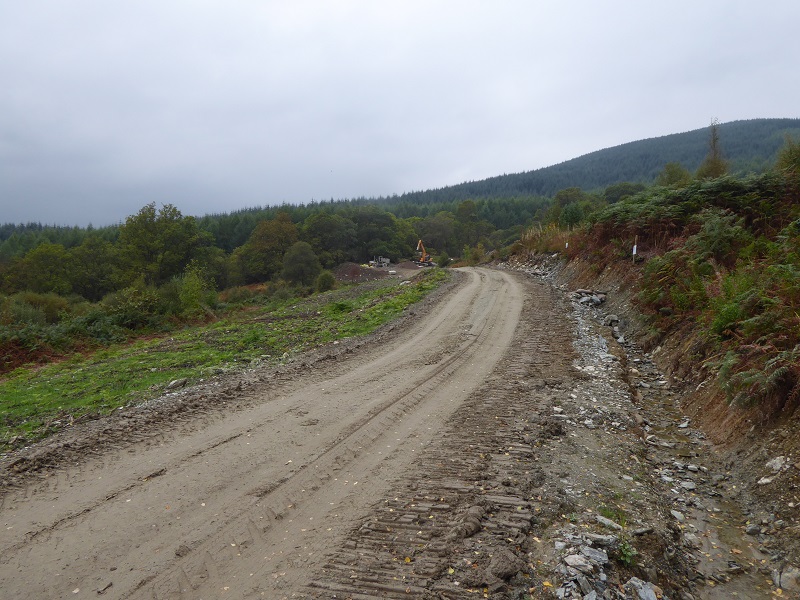
In September, alerted by a local row about breach of planning conditions at the Ledard Hydro scheme on Board Member Fergus Wood’s property, I discovered that a few weeks earlier a retrospective planning application had been submitted for an access track to the intake (see here) and started to scrutinise the documents on the LLTNPA planning portal. There was nothing I could find in the published documentation to show that a temporary construction track to the Ledard Hydro Intake had ever been approved by the LLTNPA, but I wrote to them asking them to confirm the planning status of the track just to make sure. In an email dated 28th September (which I quoted in my second post on Ledard (see here)) the Case Officer stated:
“I can confirm that the temporary track which has been constructed does not have planning permission”.
From this I concluded that the track had been unlawfully constructed on a Board Member’s Land and wrote to the Convener of the LLTNPA, James Stuart, to bring this to his attention and to ask him to investigate. I believe breach of the planning system by Board Members should be treated as a very serious issue. His reply, which staff appear to have drafted, claimed that the track had had planning permission but without providing any details, so I issued this challenge:
There is no document I can find on the planning portal that describes a temporary track, as has been constructed, and therefore it appears a temporary track in its current form has not been approved. Please do ask staff to provide both you and I with the document that shows the current temporary track was ever approved (line, construction method etc). If its there, I will be content, if its not, there is an issue.
Hey presto, when checking the planning portal for this post, four new documents had appeared although I have so far not been told about this! According to these, the case officer who told me the track had not been granted planning permission was totally wrong as the portal now shows a full specification for temporary and permanent access tracks dated 24th April 2017 (see here). So how could the LLTNPA have had this document for six months and the Case Officer did not know about it? Perhaps she, like I and other members of the public, only had access to published information?
Because LLTNPA has a history of changing documentation, I have started to keep records of what appears on the planning portal (and would recommend others do so until the LLTNPA puts basic governance procedures in place) and therefore have proof the documentation has been changed:
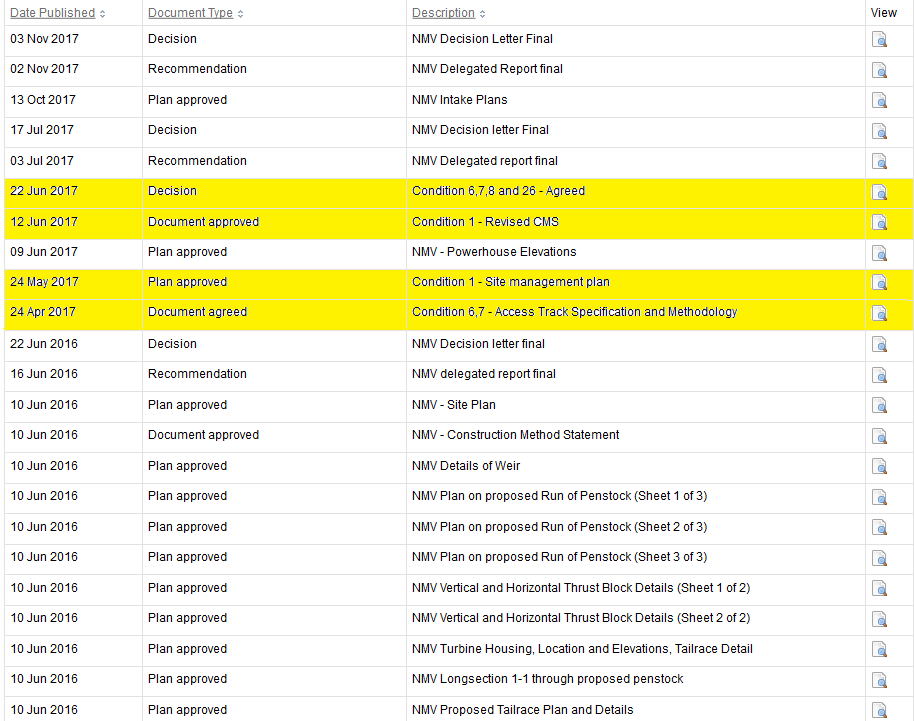
The documents highlighted in yellow were NOT published on the dates shown, which is fairly apparent for the lower two as they are not in date order, but the proof of this is from photo I took on 29th September:

The changes to the documentation on the planning portal involve two fundamental failures in governance. First, as I have long argued, the LLTNPA should be publishing all documents relating to the satisfaction of planning conditions as they appear. If Baby Hydro, acting on behalf of the Developer, really did submit the specification for temporary and permanent access tracks in April, as required by the planning conditions for the development, and if this really was approved back in June the documents should have appeared on the portal then. That would have saved a lot of bother. Second, when documents are added retrospectively dates should NOT be falsified (another example of this took place with Fergus Wood’s application for a campsite at Ledard (see here).
The LLTNPA told me NOTHING about the existence of these documents in correspondence until I issued my challenge to the Convener (well done him for getting staff to act) and they are NOT referred to in the Committee Report. This may be because the Access Track Specification dated 24th April makes it clear that the Developer intended the construction track to be anything but temporary:

while the LLTNPA, by approving this specification in June, had effectively agreed to a permanent access track on the east side of the Ledard Burn before someone realised this lay outwith the existing planning consent and indeed contradicted the previous decision of the Board.
What has gone wrong
The Report to Committee Planning_20171218_Agenda6_Ledard-Farm stated that the original approval given in December 2014, besides approving a permanent track on the west side of the burn “also included a temporary access track for construction of the hydro scheme which was to be located on the route of the pipeline”. The go ahead for construction of this track was dependent on detailed proposals being submitted for approval in the Construction Method Statement:.

However, the original Construction Method Statement dated 10th June 2016 and approved by the LLTNPA contained no reference to any temporary track or how it might be constructed which is why I and presumably the Case Officer deduced the track was constructed without planning permission.
An explanation for this can be found in the Landscape Visual Assessment:


This suggests that the Construction Method Statement contained no information about a temporary construction track because it had been decided such a track was not considered necessary. Instead the use of low ground pressure vehicles to construct the pipeline would obviate the need for a track and, where the ground was soft, it could be protected by laying stone on a sheet which would later be removed. This helps explain why none of the site maps show a temporary construction track by the pipeline but instead refer to a construction corridor:
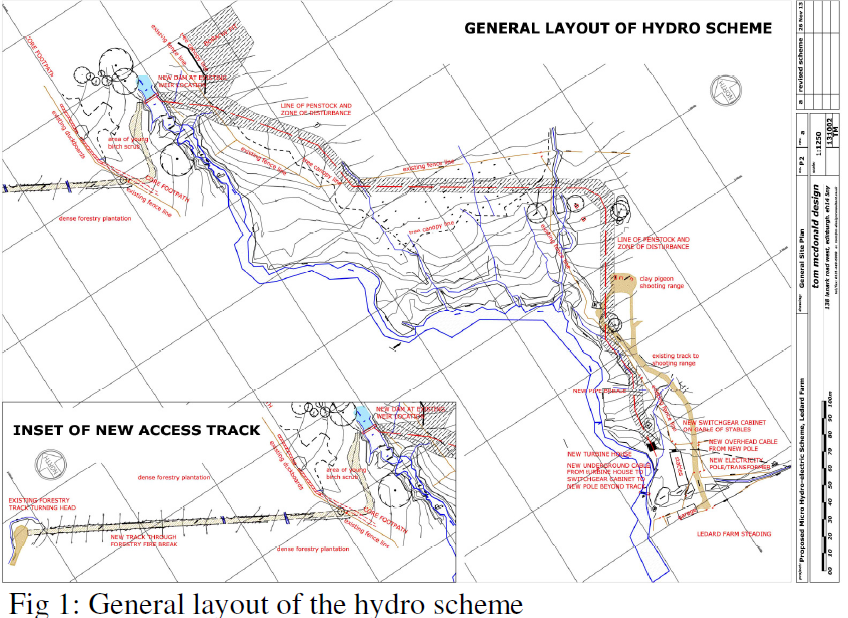
Such an approach made perfect sense given that in December 2014 the LLTNPA had decided any permanent track on the east side of the Ledard burn would be unacceptable in landscape terms and the cost of importing aggregate to construct a track and then removing it would be significant. Better to find an alternative means of constructing the pipeline.
About the same time the original Construction Method Statement was approved, however, the LLTNPA also approved an application from Fergus Wood, through a Non-Material Variation to the planning consent (see here), to remove the proposed permanent access track on the west side of the burn (see inset above for location of this track). The result was Ledard was a hydro scheme without any permanent access track.
How did the LLTNPA allow this to happen when the recent report to the Planning Committee stated: “The proposed track is assessed to be reasonably necessary for the operation and maintenance of the hydro scheme” ? If access tracks are judged necessary, the LLTNPA, in approving the removal of the permanent access track from the west side of the burn, were in effect giving the go ahead to the creation of a permanent track on the east side of the burn, where it had previously been rejected, without any Committee approval. This should have never happened.
To cap it all, the conclusion of the Report to the Planning Committee then says:
“It is considered that a permanent track constructed at 2–2.5m width, with a central vegetated strip, would have less residual impact over the long term than the alternative option of no permanent track to the intake.”
The hyprocrisy is staggering: if staff had not consented to removal of the track on the west side of the burn (which was through woodland and totally hidden) the question of whether a permanent track would have more impact than ATV use would never have arisen. It appears the LLTNPA has allowed their original decision, which was based on the need to protect the landscape, to be undermined incrementally by the actions of a former Board Member and Member of the Planning Committee.
The reason for this is, I suspect, money. An earlier application to build a hydro on the Ledard Burn was withdrawn PSC_2013_0006-Withdrawn-100094334 because the owner of the land on the west side of the Ledard Burn had held the developer to ransom – i.e they had demanded huge fees for a new access track. A possible explanation for what has happened therefore is that Fergus Wood was still faced with very high charges for the track on the west side of the burn, which affected the value of the hydro scheme. However, by getting the LLTNPA to agree to remove the requirement for an access track in this location (and this consent was granted to Fergus Wood (see here)), the value of the scheme would have increased significantly. It was then sold to Vento Ludens. If this is right, the National Park appears to have gained nothing from the increase in financial value to the scheme to the owner and the landscape appears to have been put second to a former Board Member’s and the Developer’s profits.
The LLTNPA’s flip flop approach to landscape assessment and protection
Back in 2013 the LLTNPA’s landscape adviser judged that any permanent track on the east side of the Ledard burn would have an unacceptable landscape impact but now, just four years later:
“The National Park Landscape Adviser is satisfied that the track can be well integrated into the local landscape with the mitigation of compensatory planting and landscaping.”
The Planning Committee Report, maybe in an attempt to justify this volte face, claims that:
“The proposed route of this track was different from the current proposal under consideration. It was located further to the east and its proposed alignment was very angular involving a number of right angled turns as it traversed the hill rather than the current proposed track which has a more natural alignment, utilises a section of existing track close to the farm buildings and provides a more direct access route to the intake of the hydro scheme.”
The Committee Report however fails to refer to the original Environmental Assessment:
“4.6 Access and Maintenance Track
Initially a new track was proposed across open field areas from Ledard Farm to the dam. Because the contours of the area preclude a short direct route; it would have been quite prominent in more distant views, particularly looking over to Ledard from various observation points on the road above Loch Ard on the south side.”
The Committee Report fails to explain why the short direct route is now deemed acceptable or to mention that the gradient of the uphill track exceeds the 14% maximum recommended by Scottish Natural Heritage in their Good Practice Guidance on hill tracks. Why?
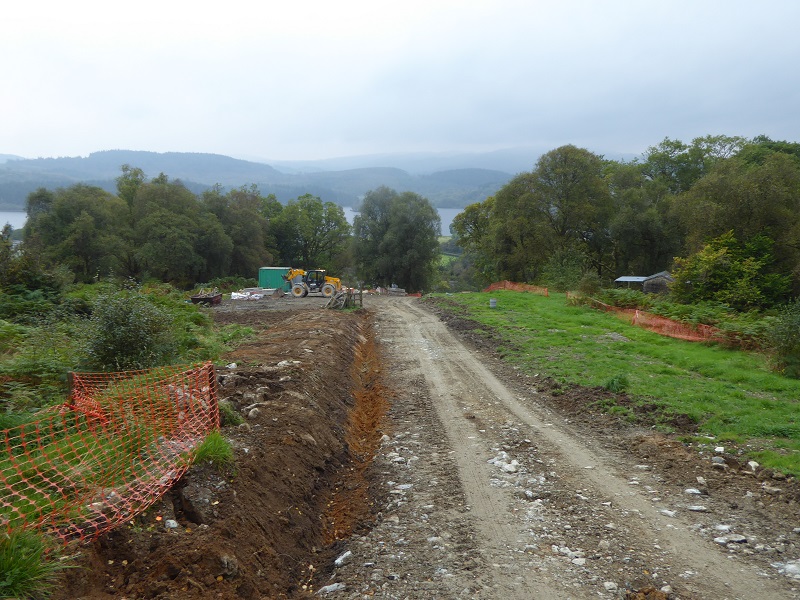
The consistency of the Ledard Hydro track approval with other decisions
Its not just the internal logic of the LLTNPA which raises serious issues in this case, its also consistency with other decisions. In January 2017 the LLTNPA refused an application for a 35m track in a field in the village of Kinlochard due to its landscape impact (the Ledard Hydro track is 385m or over 10 times as long). The applicant appealed and the appeal was due to be heard by the Local Review Body last June (see here) although it was then withdrawn.
The papers are worth a read because of the really strong statements (e.g The proposal conflicts with clear planning objectives and policies that seek to protect views, scenic quality, amenity and special landscape character within the National Park) about the need to protect the local landscape in the photo below:
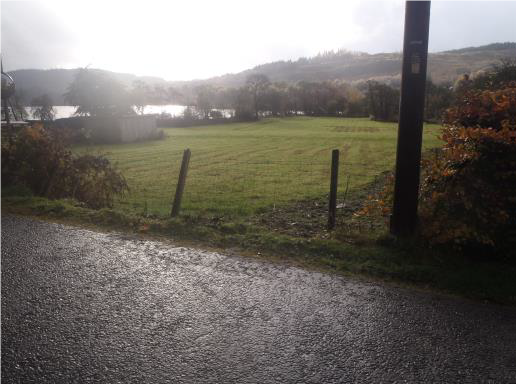
So how does the LLTNPA explain the approach it has taken in this case compared to the Ledard Hydro Track just down the road? Well, its because the track was judged not to be essential but then nor would the Ledard track if the LLTNPA had insisted the original plan for the track through the woods be retained.
While it looks from the documentation that has appeared on the planning portal as though I owe an apology to Fergus Wood for claiming that the construction track on his land was outwith any planning consent, the case still suggests he has exploited deficiencies in the LLTNPA’s planning system to further his own interests.
What needs to happen
In my view the LLTNPA still needs to conduct a full investigation into what has gone wrong in this case. While initially, after I had been informed the new track had been constructed without planning permission, I thought this should have focussed on the LLTNPA’s failure to take enforcement action, now I think it should focus on how the LLTNPA ever agreed that an access track on the west side of the Ledard Burn was no longer necessary and the impact this had on the financial value of the scheme.
The Ledard Hydro track also shows is that the LLTNPA’s approach to landscape assessment is extremely poor. Part of the problem was no proper independent visual assessment of the track was included in the Committee Report but the problem is wider than that. At present responsibility for assessing landscape impact lie with a few individuals who, while working within certain policies inevitably take different approaches, with the result that decisions are inconsistent. I believe the LLTNPA could learn a lot from the Cairngorms National Park Authority who firstly involve Board Members far more in decision making (which means that decisions are taking collectively rather than by individuals) but equally importantly go on far more site visits. This leads to better informed decisions. The Planning Committee should NEVER have agreed to reverse the decision of the earlier Committee without such a visit and without a full landscape assessment.
Hope though may be on the horizon. At the last Board Meeting a Board Member raised the issue of delegated decisions by planning staff. He suggested this required review. The LLTNPA Convener, James Stuart, put it to the Board that the scheme of delegation should be reviewed and this was agreed. This is most welcome and, if it takes account of the lessons that can be learned from the way the Ledard hydro track has been managed, could help avoid such fiascos which undermine the reputation of our National Parks in future.

A temporary track will be invisible in a couple of years … its clean energy ! this article is so irritating!
Richard, the track is not temporary, its permanent and in an area where the National Park previously said there should be no permanent track. If the construction track had been removed as originally planned there would be no issue, Nick